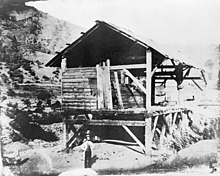James W. Marshall
This is an accepted version of this page James Wilson Marshall (October 8, 1810 – August 10, 1885) was an American carpenter and sawmill operator, who on January 24, 1848, reported the finding of gold at Coloma, California, a small settlement on the American River about 36 miles northeast of Sacramento.
The wave of gold seekers turned everyone's attention away from the mill which eventually fell into disrepair and was never used as intended.
[1] James Wilson Marshall, of English descent, was born to Philip Marshall and Sarah Wilson (married 1808) at the family homestead in Hopewell Township, New Jersey (then part of Hunterdon County, New Jersey, currently part of Mercer County) on October 8, 1810.
In 1816, the Marshall family relocated to nearby Lambertville, where Philip constructed a still-surviving house on approximately five acres of land.
He joined an emigrant train heading west and arrived in Oregon's Willamette Valley in the spring of 1845.
He also helped Marshall to buy two leagues of land on the north side of Butte Creek (a tributary of the Sacramento River) and provided him with cattle.
Marshall volunteered and served under Captain John C. Frémont's California Battalion during the Bear Flag Revolt.
His crew consisted mainly of local Native Americans and veterans of the Mormon Battalion on their way to Salt Lake City, Utah.
Marshall, still concerned with the completion of the sawmill, permitted his crew to search for gold during their free time.
By the time Marshall returned to Sutter's Fort, four days later, the war had ended and California was about to fall under American possession subsequent to the signing of the Treaty Of Guadalupe Hidalgo on February 2, 1848.
In 1886, the members of the Native Sons of the Golden West, Placerville Parlor #9 felt that the "Discoverer of Gold" deserved a monument to mark his final resting place.
The monument was rededicated October 8, 2010, by the Native Sons of the Golden West, Georgetown Parlor #91 in honor of the 200th Anniversary of James W. Marshall's birth.



